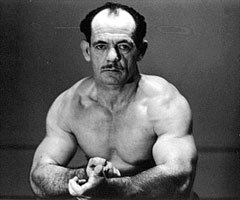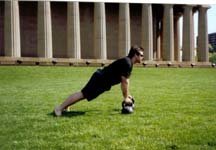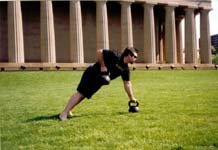Sometimes we need to work super hard and other times we are better off doing nothing at all and relaxing. However, when it comes to training, the combination of frequent practice with moderate training loads with infrequent max efforts will serve you very well on your quest to might and power.
In this article I am going to go over how to modify Mike Mentzer's controversial "Heavy Duty" program and mix it with two other controversial programs for a perfect mix for strength and size or just strength if that is your goal. What are the other controversial programs? Well, you are just going to have to read this article to find out.

Mike Mentzer:
Heavy Duty.
Many years ago, a famous bodybuilder named Mike Mentzer realized that the super high volume, high frequency, and high intensity programs that his peers were following was not the best way to go. Unless you had superior genetics and chemical assistance you did not stand a chance on these programs.
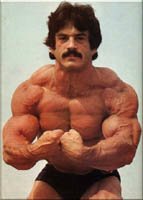
Mike Mentzer.
After meeting with the innovative and eccentric Arthur Jones, Mike was convinced that brief and frequent high intensity training was the way to go. This entailed doing one set to failure on several exercises three times per week. The program worked very well for Mike and he was back on the road to progress.
| RELATED ARTICLE | ||
|
Some time down the road, Mentzer concluded that high intensity training in which you take an exercise to muscle failure had a tremendous stress on the body and could not be done frequently. He started doing infrequent high intensity workouts and started making progress again.
-
HIT Articles:
Mike called this new program "Heavy Duty." Basically, Mike advocated doing one set to failure and then taking several days to over a week off. For example, pick a weight that you can do on the bench press and do as many reps as possible. Do the set one time and then wait several days before doing the bench press again. In theory the "Heavy Duty" Program sounds great.
| RELATED FORUM THREAD | ||
|
Hit training hard and then rest up before doing another session. However, in practice the program did not work too well for most trainees. Sure, many people had great results the first month that they tried HD (as you will with just about any program). However, after a month or so, the trainee adapts to the stimulus or in the case of HD, lack of stimulus and progress desists.
The trainees that really benefited from HD were trainees that were severely over trained. Mentzer would have trainees take two weeks off from training before starting the HD program which certainly gave them some much needed recovery time. This alone is enough to allow trainees to get back on the road to progress.
Following up with infrequent training allowed the stimulus-addicted trainees a chance to give their CNS some recovery time as well. So far HD sounds great right? Unfortunately it has some flaws that need to be addressed.
 Infrequency:
Infrequency:
-
One of the main reasons why the HD program did not work well for many trainees is not the fact that it called for training to failure (although that can be problematic), but the fact that the workouts were far too infrequent. Mentzer recommended that trainees take 7-14 days off between each exercise to maximize
recovery.
| RELATED POLL | |||
|
|||
To illustrate further, if you do the military press on November 1, you will wait until up to November 14 before doing it again. Imagine applying this concept to playing the piano or gymnastics. At best you would maintain your skill level. However, most likely your skill level would decline.
I know what you are thinking. What does playing the piano or doing gymnastics have to do with productive strength training? Far more than you may realize. Similar to playing the piano, strength training is a skill that requires practice. The more practice that you get without burning out, the more efficient you will become, and the faster you will make progress.
The problem with the HD program is that it did not take into account the fact that lifting weights is a skill. Don't agree? Think that doing an exercise such as the military press is as simple as pressing a weight from your chest to the lockout position? Then how come you have not been able to press your bodyweight after ten years of training?
Back in the day two hundred pound standing military presses were common, now they are as rare as women in Los Angeles without breast implants (not that I have a problem with that), but I digress.
Think about a time when you had to take several months off from training. Remember, that first workout back in the gym. Remember how everything just felt off? The main reason why this occurred is not because the muscles got weaker, but because your CNS had not been engaged for a while.
 |
The Central Nervous System.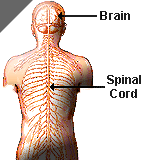 The human central nervous system consists of the brain and spinal cord. These lie in the midline of the body and are protected by the skull and vertebrae respectively. The human central nervous system consists of the brain and spinal cord. These lie in the midline of the body and are protected by the skull and vertebrae respectively. This collection of billions of neurons is arguably the most complex object known. The central nervous system along with the peripheral nervous system comprise a primary division of controls that command all physical activities of a human. Neurons of the central nervous system affect consciousness and mental activity while spinal extensions of central nervous system neuron pathways affect skeletal muscles and organs in the body. |
 |
 |
||
In some countries if you do not have sex for a long time, you are considered a virgin again. Well, to your CNS, if you do not hit a certain exercise for a long time, when you do finally hit it, your CNS is like a virgin again, no pun intended. Fortunately, it does not take too long to get back into synch. Regardless, the best way to get back into synch is to practice the skill of strength training.
One More Time:
-
Strength training is a skill. The more you practice the skill of strength training, the more you refine your form and the more efficient you get. Translation? You get stronger.
The key is to practice the skill of strength training without burning out. As Vladamir Zatsiorsky states in The Science And Practice Of Strength Training...
 Max Effort Infrequency:
Max Effort Infrequency:
-
One major thing that Mike Mentzer was correct about was the fact that maximum effort sessions should be infrequent. Maximum efforts do take a big toll on your central nervous system and cannot be executed frequently. Only average people are at their strength peak daily. Serious strength athletes only peak a few times a year if even that.
What Mentzer was wrong on was that all training should be very infrequent. Training infrequently will make you feel like you have never done the exercise before. Each time you train an exercise you will have trouble getting into the groove.
| RELATED ARTICLE | ||
|
 How Can We Make HD Effective?
How Can We Make HD Effective?
-
Simple, practice the skill of strength frequently with moderate training loads and avoidance of training to failure. Then once a month, ramp up training intensity and go all out. By combining the concept of training frequently with the concept of doing maximum efforts infrequently, we have a superior version of HD that will work very well.
One of the strongest proponents of the concept of treating strength training as a practice is top strength coach Pavel Tsatsouline, author of Beyond Bodybuilding. Pavel refers to practicing strength training as "greasing the groove." Here is how it works, take your 70% max on an exercise and do several low rep sets through out the day.
| 70% OF 1 RM CALCULATOR |
Enter the amount of weight you can lift (in pounds) and the number of reps you can lift it for.
|
For example, do a few sets of the military press in the morning, afternoon, and evening. Avoid training to failure. In fact do not even come close to training to failure. You should feel fresh and strong after each set. Another way to look at it is to take your six-rep max on an exercise and do sets of three several times a day five to six times per week.
Of course, unless you work in a gym or work at home, it will not be easy to get in several sets through out the day. Not a problem. Just do two to three sets of three to five, five times per week and take two days off.
Once a month take a dose of Heavy Duty and go all out on each exercise. Then take five days off and adjust your practice sets accordingly. Focus on compound exercises that will provide the most bang for you buck. Cut out or at least reduce all isolation work.

Sample Programs
Here are some sample programs that you can follow:
 Option 1 (strength focus):
Option 1 (strength focus):
- Barbell Military Press 2x3
- Weighted Pull-up 2x3
- Bottom Position Barbell Squat 2x3
- Stiff-Legged Deadlift 2x3
 Click Here For A Printable Log Of Option 1.
Click Here For A Printable Log Of Option 1. Take three-minute breaks between each set and one-minute breaks between each exercise. What about ab work? Take a tip from legendary bodybuilder Franco Columbu and simply contract your abs as hard as possible when doing military presses.
This is something that you should be doing anyway and will help make your midsection hard as a rock. If you have to do something, then do two sets of five on hanging leg raises or slow and controlled sit-ups.
 Option 2 (Size Focus):
Option 2 (Size Focus):
- Seated Barbell Military Press 2x6
- Barbell Bent Over Row 2x6
- Barbell Squat 2x6
- Glute/ham Raise 2x6
 Click Here For A Printable Log Of Option 2.
Click Here For A Printable Log Of Option 2. Take 75% of your six-rep max on each exercise for your practice sets. Again, take three-minute breaks between each set and one-minute breaks between each exercise. Once a month, test your six-rep max and adjust your practice loads accordingly.
| 75% OF 6 RM CALCULATOR |
Enter the amount of weight you can lift (in pounds) and the number of reps you can lift it for.
|

Louie Simmon:
Conjugate Approach.
Next, at the risk of having too many concepts at the table, we are going to apply one more. To avoid training boredom and more importantly training plateaus do to burning out pathways by doing the same exercises over and over again, we are going to apply top powerlifting coach Louie Simmons' "Conjugate Approach" to the mix.
Louie has his athletes rotate exercises every few weeks. They work up to a max on a given exercise and then rotate it with another drill. For example, work up to a max set on board bench presses, and then switch to floor presses. In addition to being a lot of fun, the conjugate approach is very effective and certainly worth taking advantage of.
Thus after, two months of applying GTG and HD to the same exercises, rotate then out for a while with some other effective selections.
 For Example:
For Example:
-
Replace
barbell military presses with
standing dumbbell upright rows.
Replace bent over barbell rows with dumbbell renegade rows.
Replace barbell squats with front squats.
You get the idea. Stick with the new exercises for a month and after you do your monthly max set, incorporate some new drills in.
Enough reading, time to practice the art of strength training often and go all out once a month. Get started today and email me with your results at mahler25@yahoo.com.
About The Author
Mike Mahler is a strength coach based in Los Angeles, CA. Sign up for tons of free training tips at www.mikemahler.com

